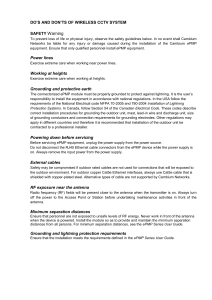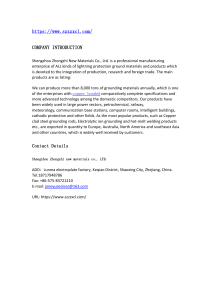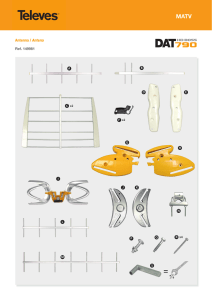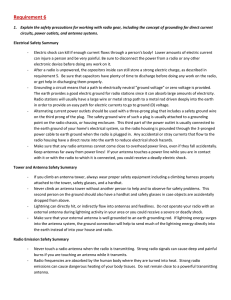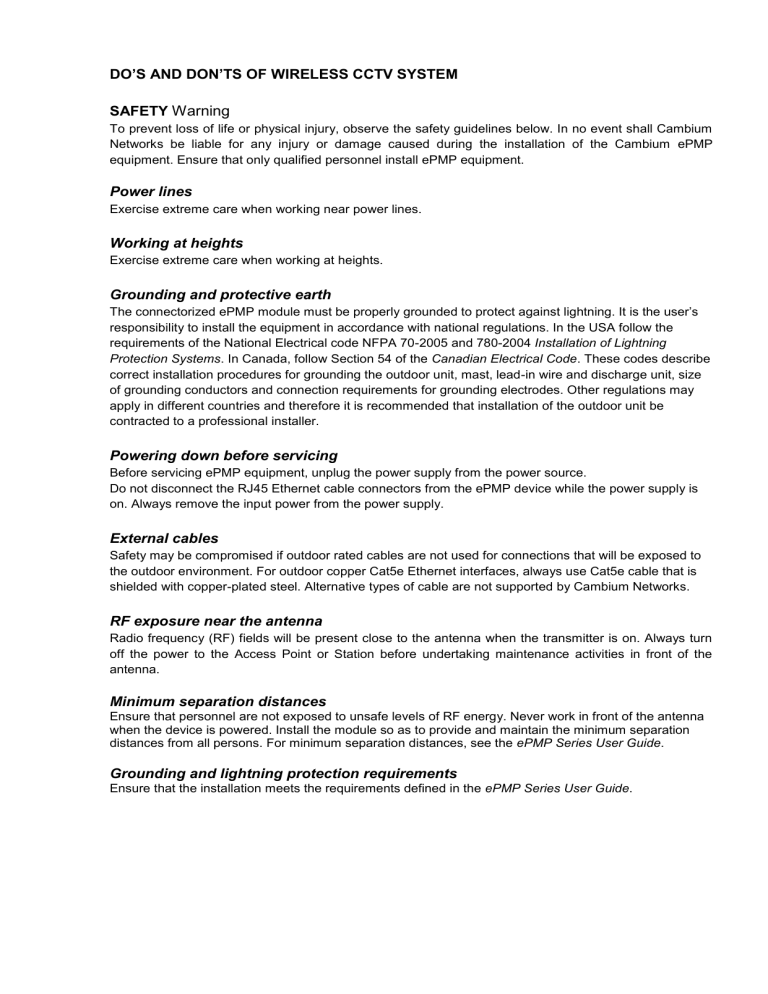
DO’S AND DON’TS OF WIRELESS CCTV SYSTEM SAFETY Warning To prevent loss of life or physical injury, observe the safety guidelines below. In no event shall Cambium Networks be liable for any injury or damage caused during the installation of the Cambium ePMP equipment. Ensure that only qualified personnel install ePMP equipment. Power lines Exercise extreme care when working near power lines. Working at heights Exercise extreme care when working at heights. Grounding and protective earth The connectorized ePMP module must be properly grounded to protect against lightning. It is the user’s responsibility to install the equipment in accordance with national regulations. In the USA follow the requirements of the National Electrical code NFPA 70-2005 and 780-2004 Installation of Lightning Protection Systems. In Canada, follow Section 54 of the Canadian Electrical Code. These codes describe correct installation procedures for grounding the outdoor unit, mast, lead-in wire and discharge unit, size of grounding conductors and connection requirements for grounding electrodes. Other regulations may apply in different countries and therefore it is recommended that installation of the outdoor unit be contracted to a professional installer. Powering down before servicing Before servicing ePMP equipment, unplug the power supply from the power source. Do not disconnect the RJ45 Ethernet cable connectors from the ePMP device while the power supply is on. Always remove the input power from the power supply. External cables Safety may be compromised if outdoor rated cables are not used for connections that will be exposed to the outdoor environment. For outdoor copper Cat5e Ethernet interfaces, always use Cat5e cable that is shielded with copper-plated steel. Alternative types of cable are not supported by Cambium Networks. RF exposure near the antenna Radio frequency (RF) fields will be present close to the antenna when the transmitter is on. Always turn off the power to the Access Point or Station before undertaking maintenance activities in front of the antenna. Minimum separation distances Ensure that personnel are not exposed to unsafe levels of RF energy. Never work in front of the antenna when the device is powered. Install the module so as to provide and maintain the minimum separation distances from all persons. For minimum separation distances, see the ePMP Series User Guide. Grounding and lightning protection requirements Ensure that the installation meets the requirements defined in the ePMP Series User Guide. Grounding cable installation methods To provide effective protection against lightning induced surges, observe these requirements: Grounding conductor runs must be as short, straight and smooth as possible, with bends and curves kept to a minimum. Grounding cables must not be installed with drip loops. All bends must have a minimum radius of 203 mm (8 in) and a minimum angle of 90°. A diagonal run is preferable to a bend, even though it does not follow the contour or run parallel to the supporting structure. All bends, curves and connections must be routed towards the grounding electrode system, ground rod, or ground bar. Grounding conductors must be securely fastened. Braided grounding conductors must not be used. Approved bonding techniques must be used for the connection of dissimilar metals. SITE GROUNDING SYSTEM Confirm that the site has a correctly installed grounding system on a common ground ring with access points for grounding ePMP equipment. If the outdoor equipment is to be installed on the roof of a high building, confirm that the following additional requirements are met: A grounding conductor is installed around the roof perimeter to form the main roof perimeter lightning protection ring. Air terminals are installed along the length of the main roof perimeter lightning protection ring, typically every 6.1m (20ft). The main roof perimeter lightning protection ring contains at least two down conductors connected to the grounding electrode system. The down conductors should be physically separated from one another, as far as practical. Installing a Connectorized Radio Cambium recommends to assemble the antenna and connectorized device prior to field deployment. To install the connectorized radio, GPS antenna, and cabling, proceed as follows: 1 2 Depress the retaining clip, then remove the bottom cover of the connectorized device. Remove the knockouts from the bottom shell cover for GPS, Ethernet, and grounding cable routing. Remove any remaining plastic burrs which may damage cabling. 3 With a Philips screwdriver, remove the GPS cover (2 screws), radio protective cover and radio mounting bracket (4 screws) to prepare the antenna for GPS antenna mounting 4 5 6 Route the GPS antenna cable down through the antenna housing, and secure the GPS antenna to the top of the sector antenna (magnetically) Reattach the radio mounting brackets to the sector antenna with a Philips screwdriver (4 screws), ensuring that the GPS antenna cable is routed through the opening at the bottom of the radio mounting brackets Attach the radio module to the sector antenna by hooking the top of the unit to the bracket then installing the retaining thumbscrew 7 Pack the Ethernet port with dielctric grease, then insert one end of the Ethernet cable into the ETH port 8 Tighten the GPS and sector antenna cables, then use overlapping wraps of vinyl tape to seal. 9 Reinstall the antenna’s GPS cover and (2) screws with a Philips screwdriver then reinstall the connectorized device antenna cabling cover and bottom shell cover (ensure that the bottom shell is latched – you may need to hold the tab/latch open when reinstalling the bottom cover).
